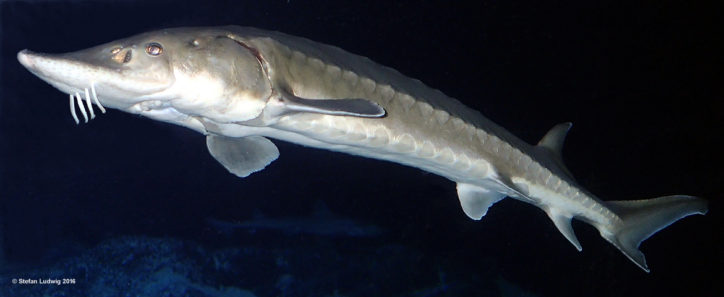Fish of the Acipenser genus of the Acipenseridae family of the Acipenseriformes order of the Chondrostei subclass.

(Atlantic sturgeon. Photo by © Stefan Ludwig. wanderfische.de)
Atlantic sturgeon (Acipenser sturio) was first described in 1758 by the Swedish scientist Carl Linnaeus (1707 – 1778). It is a diadromous fish. It inhabits sea waters at the depths of 4-95 meters, usually 5-60 meters deep. It spawns in large rivers and their pre-mouth areas. Juveniles live here for the first few years. The recorded maximum length is 600 cm. Individuals up to 125 cm long are more common. The maximum weight is 400 kilograms. It feeds on crustaceans, mollusks, polychaetes and small fish.

(Atlantic sturgeon. Photo by © Andreas Svensson. fishbase.org)
Most likely, it is extinct in the Adriatic Sea and the rivers of the basin. It used to swim to the Po, Soca, Neretva, Drin, Buna (Bojana) and other rivers. Recent records of encounters with the Atlantic sturgeon are dated 1998 in the Buna (Bojana) River and 1994 in the Po River.
It is listed in the IUCN Red List as a species remaining in critical condition (CR).
Names of Atlantic sturgeon (Acipenser sturio) in other languages are as follows:
Blini (Albanian), Атлантическа есетра (Atlanticheska jesetra) (Bulgarian), Jeseter velký (Czech), Steur (Dutch), Esturgeon commun (French), Europäischer Stör (German), Οξύρυγγχος ευρωπαϊκός ή στούριο (Oxyrinkhos evropaikos i sturio) (Greek), Közönséges tok (Hungarian), Storione (Italian), Esturión (Spanish), Jesiotr zachodni (Polish), Solho (Portuguese), Șip (Romanian), Атлантический осётр (Atlanticheskij osjotr) (Russian), Atlantska jesetra (Croatian, Serbian), Atlantski jeseter (Slovenian), Kolan balığı (Turkish).